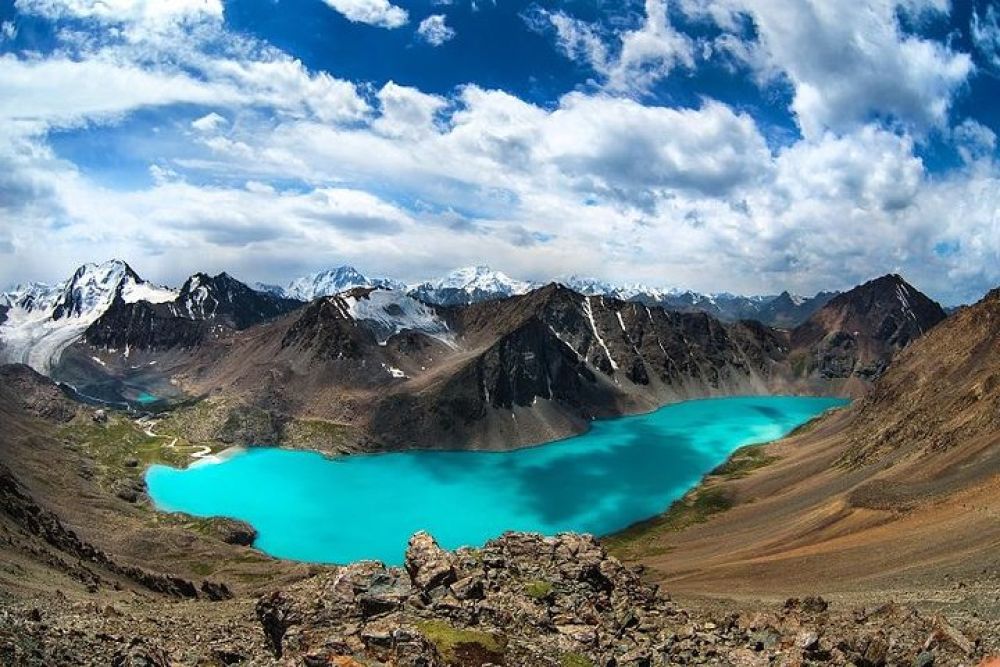

Ala-Kul Lake, often spelt as Ala-Köl, meaning "the variegated lake" in Kyrgyz, is an alpine lake in the Terskey Alatau mountains of the eastern Kyrgyzstan region, near the city of Karakol. Renowned for its magnificent landscape and diverse hues of colors ranging from deep blue to turquoise, the lake sits at an altitude of approximately 3,500 meters above sea level. It has long captured the imagination of hikers, nature enthusiasts, and photographers alike.
Ala-Kul Lake's tourism history can be traced back to the days of the Silk Road when intrepid explorers and traders passed through the region. The natural beauty of the area was a well-kept secret, known mostly to local nomads and some of the adventuring souls of the Silk Road. It wasn't until the Soviet era that the region started to gain recognition as a potential tourist destination.
With Soviet investments in the infrastructure of the neighboring areas, such as Issyk-Kul, the pristine wilds of Kyrgyzstan slowly opened up to domestic and a limited number of international tourists. Hiking routes were established, and the lake began to feature in guidebooks and adventure itineraries. However, international tourism was still minimal due to the restrictive political climate.
After the dissolution of the Soviet Union in 1991, Kyrgyzstan emerged as an independent country. There was an initial period of economic hardship and political instability which slowed the development of tourism. Nevertheless, the nation's rich cultural heritage and the untouched beauty of its mountainous landscape held much potential.
By the early 2000s, Kyrgyzstan's government recognized the role that tourism could play in the nation's economy. Efforts to promote destinations like Ala-Kul Lake increased. The introduction of more accommodating visa policies, improved infrastructure, and investment in tourism facilities started to put places like Karakol and Ala-Kul on the map for international travelers.
Today, Ala-Kul Lake is a centerpiece attraction in Kyrgyzstan's burgeoning tourism industry. The hike to the lake, often done as part of a multi-day trek that can include visits to hot springs and other nearby lakes, is a rite of passage for many adventure tourists. The trek typically starts in Karakol before winding through lush forests, alpine meadows, and rocky passes.
The government and various NGOs in Kyrgyzstan continue to promote sustainable tourism practices to preserve the natural environment of places like Ala-Kul Lake for future generations. With increased digital connectivity and global interest in off-the-beaten-path destinations, tourism in the region has taken on an eco-conscious focus. Homestays, eco-lodges, and local guides have become integral parts of the Ala-Kul Lake tourism experience, aiming to benefit the environment and the local communities.
In recent years, social media has played a significant role in raising the profile of Ala-Kul Lake and the surrounding region. Instagram, in particular, has made the lake's stunning scenery a lure for international visitors seeking the perfect photograph. The trend towards experiential and sustainable travel has further boosted Ala-Kul Lake's appeal to a global audience hungry for authentic, untouched natural environments.
With its combination of natural beauty, adventure, and cultural experiences, the region around Ala-Kul Lake continues to grow in popularity. As a result, it stands as a testament to Kyrgyzstan's ongoing commitment to developing a tourism industry that celebrates the nation's unique landscape and cultural heritage.